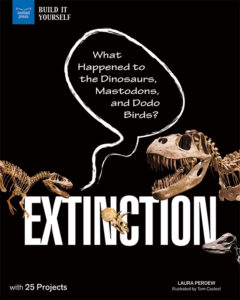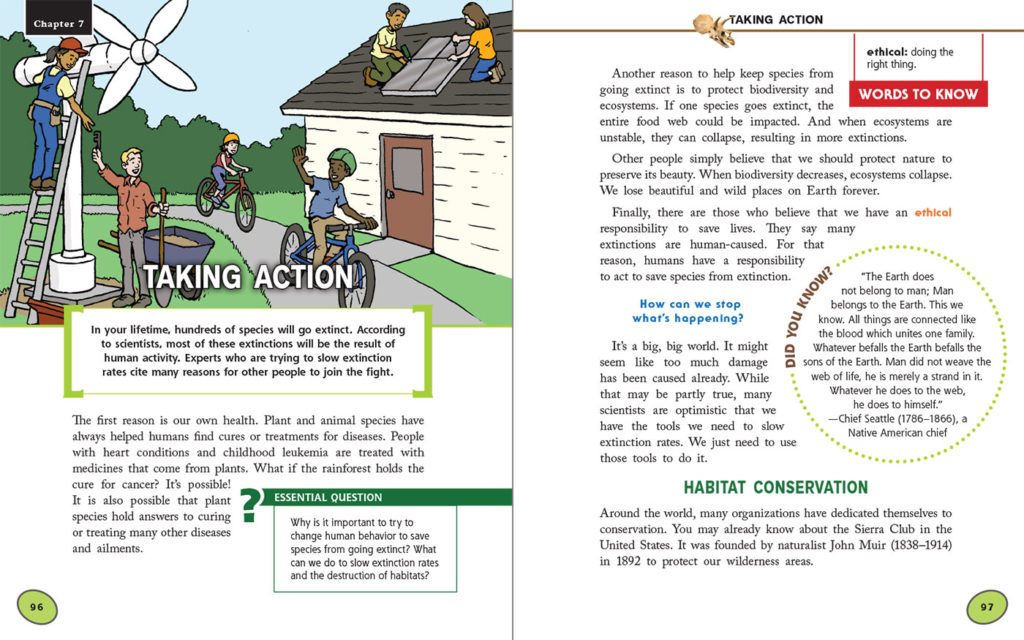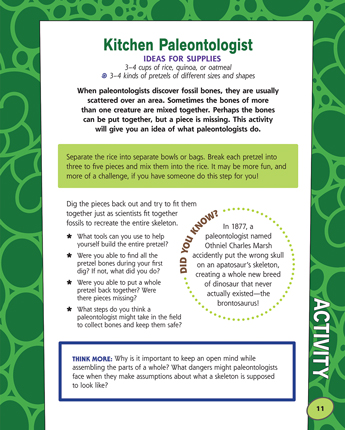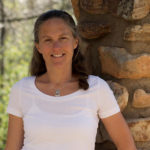“Talking to Kids About the Sixth Mass Extinction”
I think that when most people hear the word ‘extinction,’ dinosaurs come to mind first. But the truth is, billions of species have gone extinct in Earth’s 4.5-billion-year history.
Many of these were background extinctions, a normal part of life on this planet. There have also been five mass extinctions—events that wiped out more than 50 percent of species at one time. Perhaps the most well-known of these is the asteroid that hit the earth 66 million years ago and wiped out those dinosaurs.
What is not well-known, however, is that there is a sixth mass extinction currently underway.
The normal background extinction rate for mammals is one extinction every 100 years. But in the past 100 years, there have been more than 40 extinctions. Looking at all species on Earth, everything from the smallest microbes to the largest mammals, scientists estimate that the current extinction rates are 1,000 to 10,000 higher than normal. But unlike the previous five extinctions, this one is our fault.
We spend a lot of time talking about climate change, but we also need to pay more attention to the species that are dying off because of that and other human-related causes.
It’s time to spread the word. Before I wrote Extinction: What Happened to the Dinosaurs, Mastodons, and Dodo Birds?, there weren’t any books for kids that talked about the sixth extinction or what they can do to help slow this trend. Kids need to know what’s happening to the planet they are inheriting. And they need to be empowered to take action. In some ways, it seems a daunting task to stop extinctions. But history has proven that one person can make a difference in the world, and that together we can do even more.
It’s important to start the discussion with kids and to show them that even at their age, there are things they can do to create positive change. Here are some ideas!
Activity: Start the Discussion
If the scientists’ predictions are right, three out of four species will go extinct over the next few hundred years. What will the world be like? Take students outside so they can get a better understanding of this prediction. Have students list the different species they observe. Encourage them turn over rocks, crawl in a garden, think about what is underground, or look in a tree. Remind them to include insects, mammals, reptiles, amphibians, birds, trees, and plants. Can they find 10? 20?
Once they have a list, ask students to cross out three out of every four of those species on it. For this activity, those crossed off species are the ones that will become extinct.
Questions for discussion:
- Are the extinct species part of the food chain? What will happen to the other species that rely on that species for food or shelter?
- What will happen to species when their main predators die off?
- Can the ecosystem can be healthy, even with those missing species? Why or why not?
- Can some of the surviving species adapt? What adaptations would they need to survive?
Activity: Taking Action
Another way to get kids thinking about extinction is to have them think about their own carbon footprint. Start with a discussion of the terms “carbon footprint” and “carbon emissions.” Then, discuss and list the things humans do that require burning fossil fuel. Each of these activities contributes to global warming and ocean acidification, and ultimately to increased extinction rates. But there are things we can do to reduce carbon emissions.
There are many online resources that can help students research this, including NASA’s Climate Kids website (https://climatekids.nasa.gov/), and other carbon footprint calculators. The purpose of the activity is to have students identify their own actions that contribute to carbon emissions and what actions they can take to reduce their carbon footprint.
Questions for discussion:
- What can you do in your home or community to reduce your carbon footprint?
- Will making changes in how you live be easy or difficult?
- Calculate the carbon emission reduction if everyone in the class took one step to reduce their carbon footprint. What would the savings be if each student could also convince three other families to do the same thing? How about if 1,000 families in the community took steps to lower emissions?
Activity: Planning for the Future
Tell students they are a team of engineers for a new town that’s going to be built. All that’s there right now is a mix of prairie and forest. Their job is to make it as green as possible. They must find a way to balance the need of humans and the needs of the environment and the species that live there.
Start by researching what makes a city green. Also, students must consider all the things in a town that people need—homes, schools, food stores, etc. They can even discuss their own town or city as an example of things you want to include (or omit) in the town they design and build. Possible activities include collages, models, dioramas, or drawing. The focus should be on the green details.
Questions for discussion:
- What was easy about creating a green city? Difficult?
- What was difficult about balancing the needs of the environment with the needs of people?
- What can be done in their own town or city to move it towards being more green?
Discussions and research lead to awareness. Awareness leads to action. And action creates change!
Extinction: What Happened to the Dinosaurs, Mastodons, and Dodo Birds? (with 25 Projects)
Published September 15th, 2017 by Nomad Press
About the Book: Have you seen a dodo bird recently? Do you have mastodons playing in your back yard? Not likely—these species are extinct. In Earth’s 4.5-billion-year history, more than 5 billion species have gone extinct, some of them at the same time. In Extinction: What Happened to the Dinosaurs, Mastodons, and Dodo Birds? readers ages 9 to 12 learn about the scientific detective work scientists perform to find the culprit behind mass extinctions, including the present-day, sixth mass extinction.
About the Author: Laura Perdew is an author, writing consultant, and former middle school teacher. She has written more than 15 books for the education market on a wide range of subjects, including the animal rights movement, the history of the toilet, eating local, and the Great Pacific Garbage Patch. She is a long-time member of the Society of Children’s Book Authors and Illustrators. Laura lives in Boulder, Colorado.
Thank you, Laura, for pushing us to start this conversation with our students!






